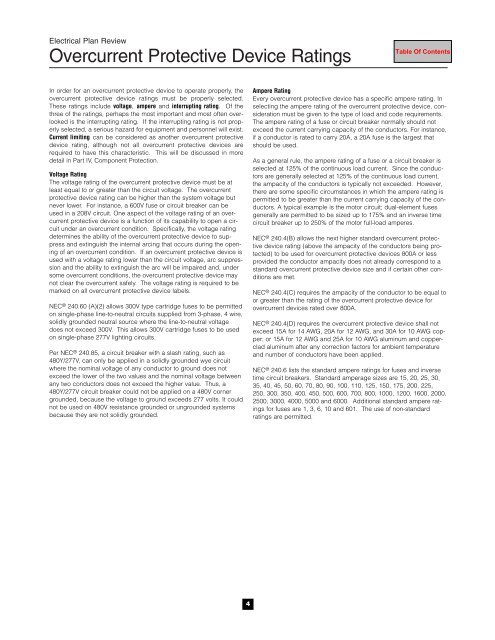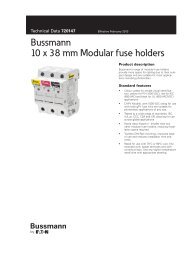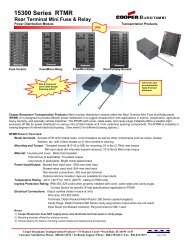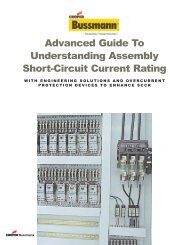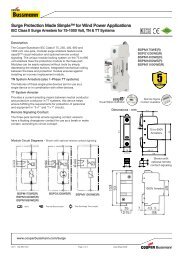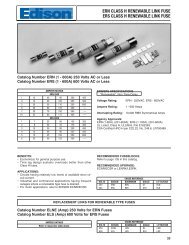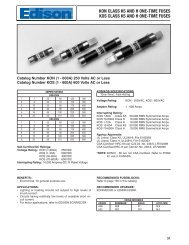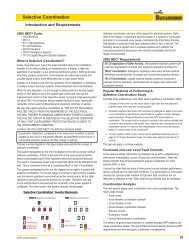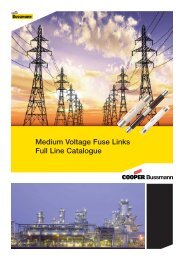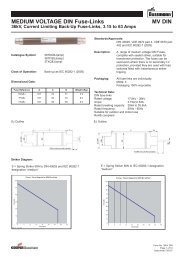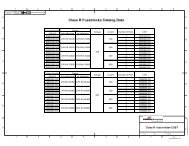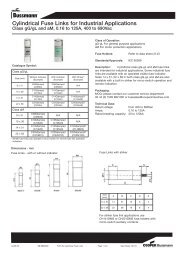Overcurrent Protection and Devices, Short-Circuit Calculations ...
Overcurrent Protection and Devices, Short-Circuit Calculations ...
Overcurrent Protection and Devices, Short-Circuit Calculations ...
Create successful ePaper yourself
Turn your PDF publications into a flip-book with our unique Google optimized e-Paper software.
Electrical Plan Review<br />
<strong>Overcurrent</strong> Protective Device Ratings<br />
In order for an overcurrent protective device to operate properly, the<br />
overcurrent protective device ratings must be properly selected.<br />
These ratings include voltage, ampere <strong>and</strong> interrupting rating. Of the<br />
three of the ratings, perhaps the most important <strong>and</strong> most often overlooked<br />
is the interrupting rating. If the interrupting rating is not properly<br />
selected, a serious hazard for equipment <strong>and</strong> personnel will exist.<br />
Current limiting can be considered as another overcurrent protective<br />
device rating, although not all overcurrent protective devices are<br />
required to have this characteristic. This will be discussed in more<br />
detail in Part IV, Component <strong>Protection</strong>.<br />
Voltage Rating<br />
The voltage rating of the overcurrent protective device must be at<br />
least equal to or greater than the circuit voltage. The overcurrent<br />
protective device rating can be higher than the system voltage but<br />
never lower. For instance, a 600V fuse or circuit breaker can be<br />
used in a 208V circuit. One aspect of the voltage rating of an overcurrent<br />
protective device is a function of its capability to open a circuit<br />
under an overcurrent condition. Specifically, the voltage rating<br />
determines the ability of the overcurrent protective device to suppress<br />
<strong>and</strong> extinguish the internal arcing that occurs during the opening<br />
of an overcurrent condition. If an overcurrent protective device is<br />
used with a voltage rating lower than the circuit voltage, arc suppression<br />
<strong>and</strong> the ability to extinguish the arc will be impaired <strong>and</strong>, under<br />
some overcurrent conditions, the overcurrent protective device may<br />
not clear the overcurrent safely. The voltage rating is required to be<br />
marked on all overcurrent protective device labels.<br />
NEC ® 240.60 (A)(2) allows 300V type cartridge fuses to be permitted<br />
on single-phase line-to-neutral circuits supplied from 3-phase, 4 wire,<br />
solidly grounded neutral source where the line-to-neutral voltage<br />
does not exceed 300V. This allows 300V cartridge fuses to be used<br />
on single-phase 277V lighting circuits.<br />
Per NEC ® 240.85, a circuit breaker with a slash rating, such as<br />
480Y/277V, can only be applied in a solidly grounded wye circuit<br />
where the nominal voltage of any conductor to ground does not<br />
exceed the lower of the two values <strong>and</strong> the nominal voltage between<br />
any two conductors does not exceed the higher value. Thus, a<br />
480Y/277V circuit breaker could not be applied on a 480V corner<br />
grounded, because the voltage to ground exceeds 277 volts. It could<br />
not be used on 480V resistance grounded or ungrounded systems<br />
because they are not solidly grounded.<br />
Ampere Rating<br />
Every overcurrent protective device has a specific ampere rating. In<br />
selecting the ampere rating of the overcurrent protective device, consideration<br />
must be given to the type of load <strong>and</strong> code requirements.<br />
The ampere rating of a fuse or circuit breaker normally should not<br />
exceed the current carrying capacity of the conductors. For instance,<br />
if a conductor is rated to carry 20A, a 20A fuse is the largest that<br />
should be used.<br />
As a general rule, the ampere rating of a fuse or a circuit breaker is<br />
selected at 125% of the continuous load current. Since the conductors<br />
are generally selected at 125% of the continuous load current,<br />
the ampacity of the conductors is typically not exceeded. However,<br />
there are some specific circumstances in which the ampere rating is<br />
permitted to be greater than the current carrying capacity of the conductors.<br />
A typical example is the motor circuit; dual-element fuses<br />
generally are permitted to be sized up to 175% <strong>and</strong> an inverse time<br />
circuit breaker up to 250% of the motor full-load amperes.<br />
NEC ® 240.4(B) allows the next higher st<strong>and</strong>ard overcurrent protective<br />
device rating (above the ampacity of the conductors being protected)<br />
to be used for overcurrent protective devices 800A or less<br />
provided the conductor ampacity does not already correspond to a<br />
st<strong>and</strong>ard overcurrent protective device size <strong>and</strong> if certain other conditions<br />
are met.<br />
NEC ® 240.4(C) requires the ampacity of the conductor to be equal to<br />
or greater than the rating of the overcurrent protective device for<br />
overcurrent devices rated over 800A.<br />
NEC ® 240.4(D) requires the overcurrent protective device shall not<br />
exceed 15A for 14 AWG, 20A for 12 AWG, <strong>and</strong> 30A for 10 AWG copper;<br />
or 15A for 12 AWG <strong>and</strong> 25A for 10 AWG aluminum <strong>and</strong> copperclad<br />
aluminum after any correction factors for ambient temperature<br />
<strong>and</strong> number of conductors have been applied.<br />
NEC ® 240.6 lists the st<strong>and</strong>ard ampere ratings for fuses <strong>and</strong> inverse<br />
time circuit breakers. St<strong>and</strong>ard amperage sizes are 15, 20, 25, 30,<br />
35, 40, 45, 50, 60, 70, 80, 90, 100, 110, 125, 150, 175, 200, 225,<br />
250, 300, 350, 400, 450, 500, 600, 700, 800, 1000, 1200, 1600, 2000,<br />
2500, 3000, 4000, 5000 <strong>and</strong> 6000. Additional st<strong>and</strong>ard ampere ratings<br />
for fuses are 1, 3, 6, 10 <strong>and</strong> 601. The use of non-st<strong>and</strong>ard<br />
ratings are permitted.<br />
4


